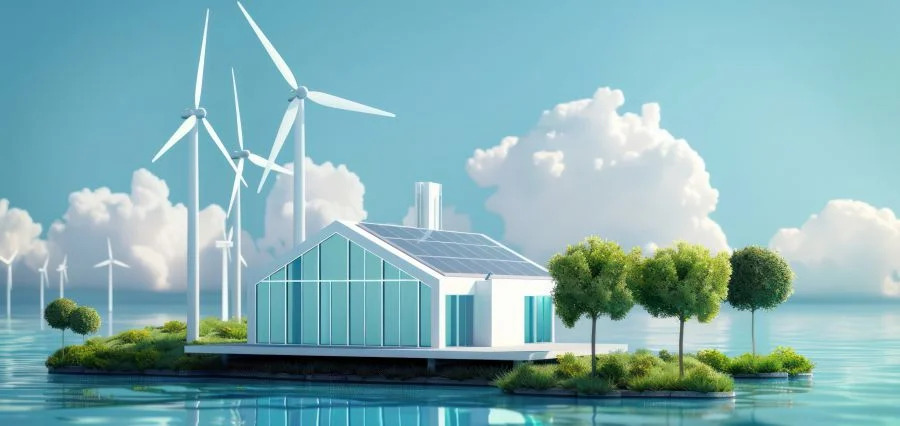Exploring Various Aspects of Green Energy Solutions
 Abhiash Nale
Abhiash Nale
Introduction
The urgent need to combat climate change and secure a sustainable energy future has placed Green Energy Solutions at the forefront of global agendas. These solutions, derived from renewable resources, offer a cleaner and more environmentally friendly alternative to fossil fuels. This article explores various aspects of Green Energy Solutions, examining their different forms, benefits, challenges, and the role they play in shaping a greener world.
Different Forms of Green Energy Solutions
Solar Power: Tapping the Power of the Sun
Solar power is one of the most widely used Green Energy Solutions, utilizing photovoltaic (PV) cells to convert sunlight into electricity. Solar panels can be installed on rooftops, integrated into building structures, or used in large-scale solar farms. With abundant sunlight available in many regions, solar energy presents a sustainable and renewable means of electricity generation.
Benefits of Solar Power
Renewable and abundant source of energy
Reduces electricity bills and operational costs
Low maintenance costs after installation
Scalable for different energy needs
Challenges of Solar Power
Intermittent availability depending on weather and time of day
Requires significant initial investment
Energy storage solutions needed for nighttime use
Wind Energy: Harnessing the Power of the Wind
Wind energy is another prominent Green Energy Solution that generates electricity through wind turbines. Both offshore and onshore wind farms have gained popularity, utilizing wind’s kinetic energy to produce clean power. Advances in turbine technology have made wind energy more efficient and economically viable.
Benefits of Wind Energy
Sustainable and renewable source
Reduces reliance on fossil fuels
Scalable for large-scale energy production
Challenges of Wind Energy
Variability in wind speeds affects power generation
Requires suitable geographic locations
Can have environmental and aesthetic impacts
Hydropower: Energy from Flowing Water
Hydropower is one of the oldest Green Energy Solutions, utilizing the movement of water to generate electricity. Dams and reservoirs store water, which is released to spin turbines and produce power.
Benefits of Hydropower
Reliable and consistent energy source
Cost-effective after initial investment
Provides flood control and water storage benefits
Challenges of Hydropower
Environmental impact on aquatic ecosystems
High initial infrastructure costs
Potential displacement of communities
Geothermal Energy: Heat from the Earth
Geothermal energy taps into the Earth’s internal heat to produce electricity. Geothermal power plants extract heat from underground reservoirs to generate power.
Benefits of Geothermal Energy
Provides a consistent and renewable energy source
Produces minimal greenhouse gas emissions
High efficiency compared to other renewables
Challenges of Geothermal Energy
Limited to regions with geothermal activity
High upfront drilling costs
Potential for surface instability
Biomass Energy: Utilizing Organic Matter
Biomass energy involves burning organic materials such as wood, crop waste, and solid municipal waste to generate heat and electricity. Biomass can also be converted into biofuels for transportation.
Benefits of Biomass Energy
Uses waste materials effectively
Can be produced locally, reducing dependence on fossil fuels
Reduces landfill waste
Challenges of Biomass Energy
Can contribute to deforestation if not managed sustainably
Requires technological advancements for cleaner combustion
Some biomass processes still produce carbon emissions
Ocean Energy: Harnessing the Power of the Sea
Ocean energy is an emerging Green Energy Solution that captures the energy from waves, tides, and ocean currents to generate electricity.
Benefits of Ocean Energy
Vast potential as oceans cover 70% of the Earth’s surface
Consistent and renewable source
Minimal land use requirements
Challenges of Ocean Energy
High research and development costs
Potential environmental impact on marine life
Limited commercial deployment so far
Integrating Green Energy Solutions with Smart Grids
Smart grids enhance the integration of Green Energy Solutions by managing supply and demand fluctuations. They help stabilize electricity distribution by optimizing energy storage and transmission.
Economic Benefits of Green Energy Solutions
Green Energy Solutions not only benefit the environment but also contribute to economic growth by creating jobs and reducing dependence on imported fossil fuels. The falling costs of renewable technologies make them increasingly competitive with traditional energy sources.
Overcoming Challenges in Green Energy Implementation
Despite their potential, Green Energy Solutions face several challenges, including:
Intermittency Issues: Energy storage solutions are required to ensure a steady power supply.
High Initial Investment: Some renewable technologies require substantial upfront costs.
Grid Infrastructure: Upgrading power grids to support renewable integration is necessary.
The Role of Policy and Regulation in Green Energy
Government policies and regulations play a crucial role in promoting Green Energy Solutions. Incentives such as subsidies, tax credits, and renewable energy mandates help drive investment in sustainable energy projects.
Technological Advancements and Innovation
Continuous research and innovation are essential for improving the efficiency and affordability of Green Energy Solutions. Advancements in battery storage, new materials for solar panels, and AI-driven energy management systems are revolutionizing the sector.
Public Awareness and Education on Green Energy
Educating the public about the benefits of Green Energy Solutions fosters widespread adoption and consumer engagement. Awareness campaigns and sustainability initiatives can encourage individuals and businesses to transition to renewable energy sources.
International Collaboration for a Sustainable Future
Addressing climate change requires global cooperation. Sharing knowledge, technological advancements, and best practices among nations accelerates the adoption of Green Energy Solutions worldwide.
Conclusion
The future of energy is undeniably green. Green Energy Solutions are not a temporary trend but a vital shift toward sustainability. With ongoing technological innovation, supportive policies, and increased public awareness, renewable energy will play a central role in reducing carbon emissions and securing a cleaner, healthier world for future generations.
Subscribe to my newsletter
Read articles from Abhiash Nale directly inside your inbox. Subscribe to the newsletter, and don't miss out.
Written by
